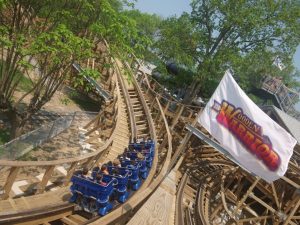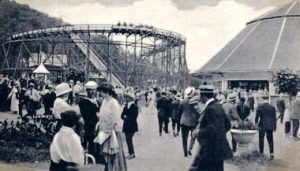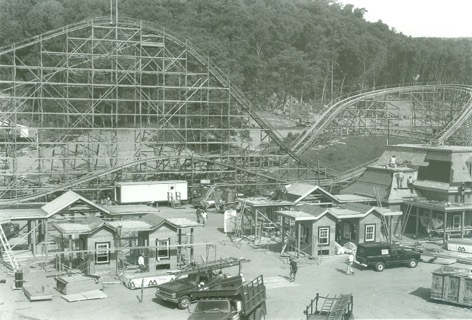New or old, roller-coasters play a special role in the state’s history of summer fun. Lake Compounce, the oldest continually operating park of its kind in the nation, opened in 1846. That’s when Gad Norton added picnic tables and nature trails around the lake at his Bristol farm in the Connecticut foothills. Boats and a bowling alley followed.
Other amusement parks around Connecticut flourished, too, by the late 19th century and early 20th century, as technology grabbed hold of American society and culture. The trolley car was a game-changer. By the early 1900s, more than 1,000 miles of trolley tracks linked towns across Connecticut. Lake Compounce was served by the Bristol and Plainville Tramway Company. Another trolley line brought visitors to the park from Meriden, Southington and points south.

In many cases, the trolley companies – 19 state-wide at one point – built the amusement parks themselves, often locating them at the end of their lines to increase weekend ridership and capitalize on a growing trend: city workers wanted to spend more of their leisure time in the country and escape from reality. Across the United States, rail companies owned and operated more than 1,000 amusement parks. Many failed after the Great Depression of 1929 and during the lean economic times during World War II.
Coasters were the highpoint of a park visit. The first electrically powered wooden roller coaster, the Green Dragon, debuted at Lake Compounce in 1914. In 1927, it was replaced by the Wildcat, another wooden coaster, which boasted an 80-foot drop at one point. Passengers raced along a 2,746-foot long track at 48 miles per hour, reaching heights of 85 feet. The ride lasted all of a minute and a half; to some, that felt like eternity.
Besides coasters, parks featured carousels and other rides, and entertainment was a major feature. At Lake Compounce, for example, a young juggler who drew crowds was named Orson Welles (yes, that Orson Welles). The magician Harry Houdini entranced visitors. So did an upcoming musician named Benny Goodman.
Over at Lake Quassapaug, the forerunner of Quassy Park, the Connecticut Trolley Company brought residents from Waterbury to the Middlebury lake, starting in 1908. Attractions included swimming, a picnic grove, dancing and a carousel. It didn’t become a full-fledged amusement park until after World War II. The Little Dipper roller coaster, installed in 1952 as part of Kiddieland, a quartet of rides, has drawn millions of young guests over the years. Tiny in comparison to mega roller coasters, the Little Dipper has a 220 foot track and a 12-foot lift hill.
“It’s been a staple of the park for generations,” says Quassy’s president, Eric Anderson, who rode the mini-coaster as a youngster.
In 1960, Quassy installed a coaster for adults, the Wild Mouse, though it was dismantled in 1983. Its replacement, the Mad Mouse, a 1966 coaster from Playland in Rye, New York, was sold and dismantled in 2010 to make way for Quassy’s first all-wooden coaster. Installed in 2011, the Wooden Warrior was an instant hit, despite its small track of 1,250 feet and maximum height of 35 feet (because of the park’s topography, the Warrior actually drops more than 40 feet along its course). Last year, Amusement Today, a trade magazine, ranked it 38th among the Top 50 wooden coasters, most of which are two to three times larger, says Quassy spokesman Ron Gustafason.
Other parks, relics of the past, boasted roller coasters, too. Among them, Savin Rock in West Haven, once considered the “Coney Island of Connecticut,” drew visitors along the Connecticut shoreline and beyond. Most visitors came by trolley in the early 1900s, and the New Haven Street Railroad invested in several attractions, including band concerts featuring John Philip Sousa.
In 1900, Savin Rock unveiled a figure-eight roller coaster, and the Racing Coaster shortly after, though both were short-lived, replaced by the White City Flyer in 1914. Several years later, a fire there swept it away along with other attractions. But in 1922, another pier was erected called Liberty Pier on Beach Street, and it included The Devil, and Thunderbolt, the latter Savin Rock’s most famous coaster, which opened in 1925. Riders of the 85-foot tall Thunderbolt swore that during its big drop, they felt certain that the coaster train was heading straight into Long Island Sound.
The Red Devil fell victim to a raging 12-hour fire in 1932 and most of Thunderbolt was washed out to sea on September 24, 1938, when a hurricane with 88- mile-per-hour winds lashed at the coaster and other attractions. Its successor, the Thunderbolt Giant Flyer, operated until 1956. It was never considered as exciting as the original, according to historians and coaster fans, and was torn down in 1957.
At Bridgeport’s Pleasure Beach, George C. Tilyou, owner of Steeplechase Park on Coney Island, New York, saw an opportunity, purchasing the beach in 1905 and calling it Steeplechase Island. He installed a figure-eight coaster around 1908 and the Sky Rocket roller coaster in 1922, but neither lasted long. During a fire in 1953, which ultimately decimated the park, firefighters climbed atop a roller coaster to put out the fire. The park reopened, but shut down six years later.

Waterbury’s Lakewood Park, which opened in 1930, also featured a wooden coaster, but it ran only a few seasons before being moved to Canobie Lake Park in Salem, New Hampshire, where it continues to operate today.
Today, the coaster industry remains competitive, with parks seeking to introduce the next sensation. In 2000, Lake Compounce introduced Boulder Dash, a wooden roller coaster traveling 60 miles per hour with a drop of 115 feet; in 2002, it was voted world’s best wooden coaster by the National Amusement Park Historical Association. This season, the park launched the Phobia Phear Coaster, a coaster propelled by electromagnetic power to gain momentum before roaring over the steep track, the first of its kind in the Northeast, say Lake Compounce officials.
The new coaster is the latest example of Connecticut playing a leading role in making roller-coaster history.
Leonard Felson, a regular contributor to Seasons, is a magazine writer whose passion for local history began at a young age. For more about him and his work, see www.leonardfelson.com.
Photos Courtesy of Lake Compounce and Quassy Amusement & Waterpark






More Stories
Haunted Apples and Bewitched Beer
Gayle King speaks to Dennis House
Everybody Remembers Their First Outdoor Concert